I’m looking at two Apple computers on my desk. They both fold open and have keyboards and trackpads. They both have 13-inch screens. They both have M-series processors. They both have USB-C/Thunderbolt ports. They both have nice, centered video cameras. One has a touchscreen and a stylus. The other runs MacOS.
Apple’s parallel computer evolution feels like it’s hit its peak in 2024, and something has to give. The new iPad Pro — thinner, nicer with a vivid OLED display — is still running the same iPadOS we’ve seen slowly evolve but never quite become a Mac. And the MacBook Air I use all the time at home, well, it doesn’t have a touchscreen.
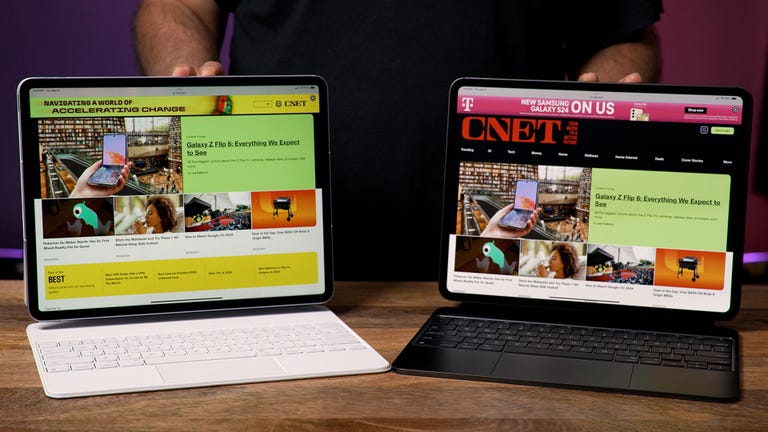
Watch this: iPad Pro and iPad Air (2024) – Review
Apple argues that people love having choices, that computers that excel at one thing or another are better. I look at the iPad Pro and think, this is the main computer I’d love to have — if it also ran MacOS.
When it comes to Macs, most people I know have a MacBook Air. For iPads, most have the entry-level, standard iPad. The new iPad Pro, however, is most definitely not basic, and it’s far from inexpensive — it’s the FancyPad. The Pro starts at either $1,000 or $1,300 depending on size — about the same as most MacBook Airs — and climbs far higher depending on the storage config, or whether you get a keyboard case or a Pencil Pro stylus (both of which I’d say are necessary to get the most out of what your nice iPad Pro can do).
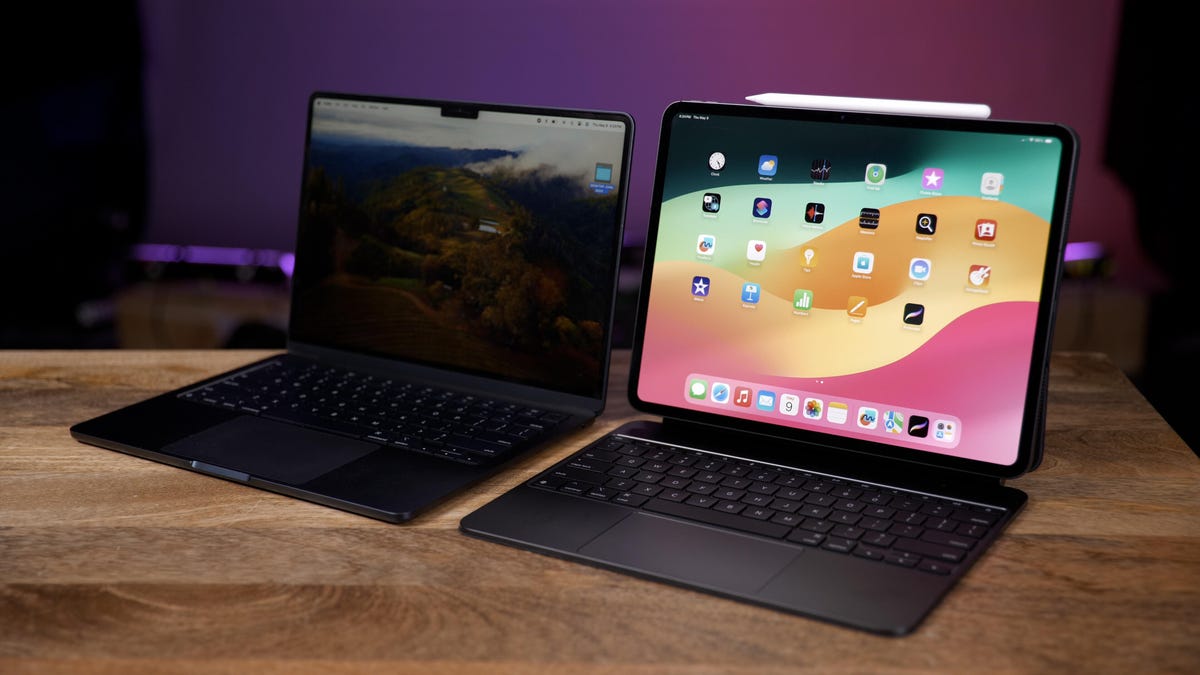
The MacBook Air M2 (left) and iPad Pro 2024 (right). These computers, with keyboards on, are starting to look more converged than ever.
In 2022, the iPad Pro was a niche device that pro artists and all kinds of creators might love. The 2024 iPad Pro makes improvements across the board, but it’s still niche. Why? Again: Because it can’t also be a Mac.

Apple iPad Pro (2024)
Like
Vivid, bright Tandem OLED display
New M4 processor is crazy fast
New camera orientation for video chats
Pencil Pro offers helpful new extras
Don’t like
Gets very expensive fast for configurations
Magic Keyboard case still not great for Pencil use
iPadOS limits this computer’s potential
I mean, look: I’m writing this review on the new iPad Pro. I love the Magic Keyboard’s keys and trackpad. I love this iPad’s lovely bright OLED display. I don’t love the price, though — and I don’t love that, for me, it still can’t be a MacBook replacement for all the things I use my Mac for, even though it’s theoretically getting closer all the time. So, it’s a secondary computer. Again.
Apple’s commercial for the new iPads shows a giant industrial press crushing so many creative things down into a little slab. Well, I’d like that big crusher to take all of Apple’s Pro computers and compress them down into one device. Just one. MacBook and iPad Pro, I command you to merge. ASAP.
Of course, merging isn’t easy. But until they do, I’m left stranded between devices now. The iPad remains lovely, and the keyboard is really, really good. It feels just like a MacBook! I’d write on this all day. And thanks to the new function key row, it really does whatever I need. Technically, the MacBook Air keyboard is a bit better for me, but it’s so close. And that’s how the new iPad Pro leaves me: Wishing, basically, this was also a Mac. Also, the new iPad Air, while not as fancy, can offer a ton of performance and Pencil Pro compatibility for considerably less.
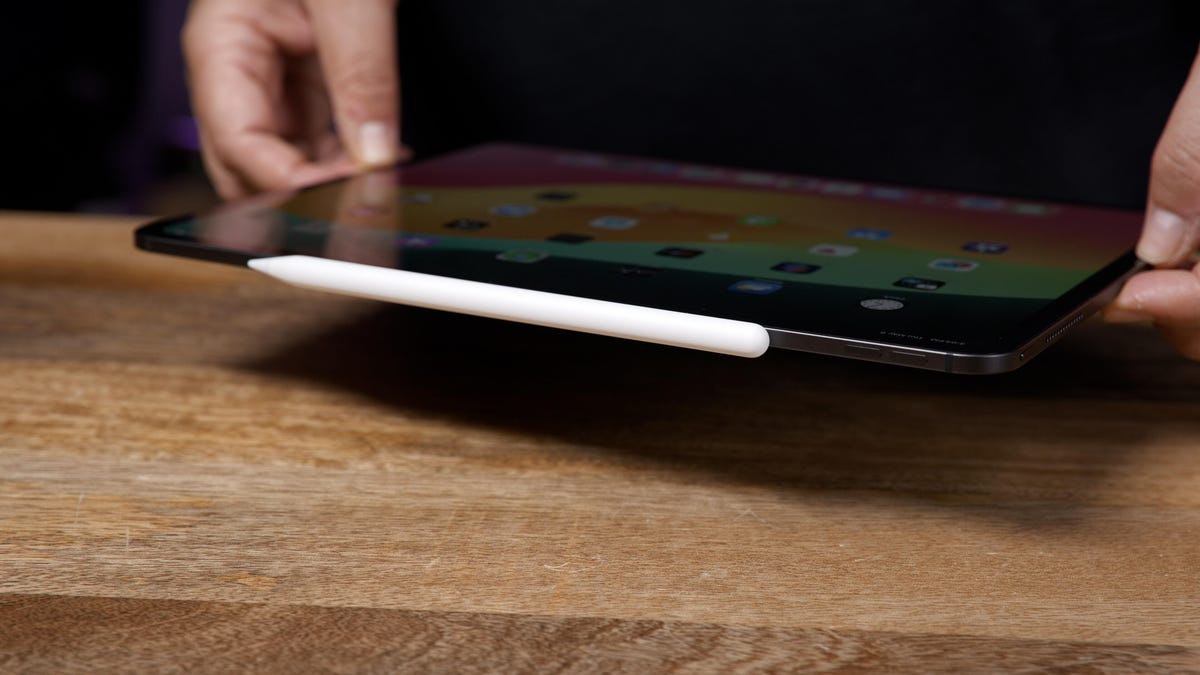
This is a thin tablet. But if you put a keyboard case on, not as much.
Thin? Sure
Apple’s endless quest for thin has resulted in this iPad Pro being technically, according to Apple, its thinnest product yet. That won’t be observable too much for me since I keep the iPad Pro in the Magic Keyboard case almost all the time. It does mean the iPad Pro-plus-Magic Keyboard combo isn’t as thick and doesn’t weigh as much.
In fact, the 13-inch iPad Pro and Magic Keyboard together weigh 2.6 pounds, which is… exactly what my 13-inch MacBook Air with M2 chip weighs. Coincidence? Oh, I think not.
Aside from worries about an iPad Pro that’s this thin being more bend-prone (which I don’t know, yet), the camera bump is still a thing. The rear camera square still pops out a bit, just like all the other models. In its case, it’s flush.
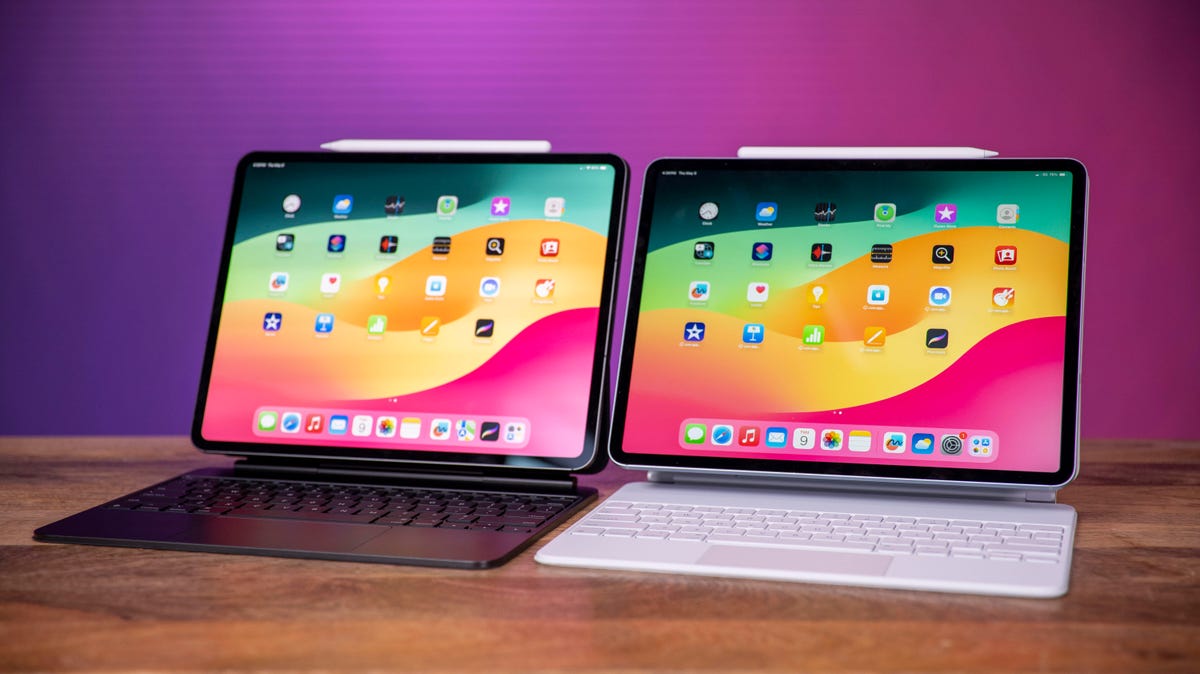
The iPad Pro (left) vs. the iPad Air (right). In photos or in some casual use, the Tandem OLED display of the Pro is hard to observe, but its brightness and dynamic range are much better.
A new OLED display I’d like in everything
Apple’s move to OLED for the iPad Pro displays feels really overdue, considering Samsung did it years ago. The tech in this display, called “Tandem OLED,” combines OLED display pixels to increase brightness and still have high contrast. In my use so far, it’s definitely very bright. The Ultra Retina Display XDR branding may sound like a lot, but it translates to pure, deep blacks, and a 1,000-nit maximum brightness versus 600 nits for the other iPads. In HDR modes, the peak brightness in certain parts of the display can go up to 1,600 nits, but that won’t appear in most everyday uses.
The display really popped for me watching movies like Dune 2 that are HDR-optimized. Dedicated art apps and optimized games (or video-editing apps) could look great, too, but it really depends on whether you’re expecting to do a lot of creative work where a big dynamic range is necessary.
This is the display I want in every Pro-level Apple computer, or just every Apple device period. The mini-LED displays in the MacBook Pro and Apple’s older 13-inch iPad Pros had deeper contrast and black levels than LCD, but the zones where black levels activated were less precise, and some bloom happened in areas where bright text or images popped up. That doesn’t happen with this OLED display.
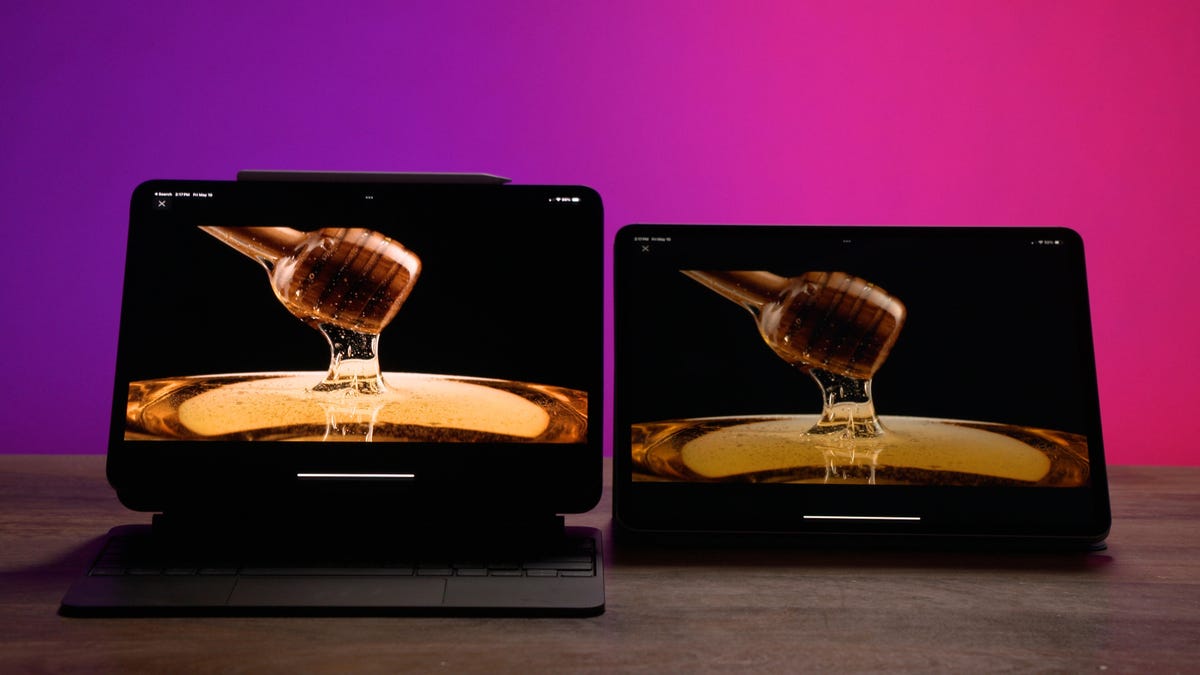
Looking at HDR content, the iPad Pro (left) OLED display shines compared to the iPad Air (right).
But a lot of everyday iPad owners don’t need to pay up for this. Much like when the iPhone X had an OLED display and the XR didn’t, the side-by-side experience with iPad Air and iPad Pro for many basic iPad apps doesn’t look that incredibly different. That’s a testament to the already good displays on existing iPads. The Pros also get the ProMotion display refresh rate (up to 120Hz), while the iPad Air and the rest of the iPad lineup do not (iPhone Pros have this, too).
Apple offers a “nano textured glass” option this time around for an extra $100, which gives a matte look to the iPad display. I saw this in person briefly a week ago, but my review unit doesn’t have the matte glass. I prefer the glossy standard option, since the matte seemed to make the display seem less vivid, although it does cut down on glare.
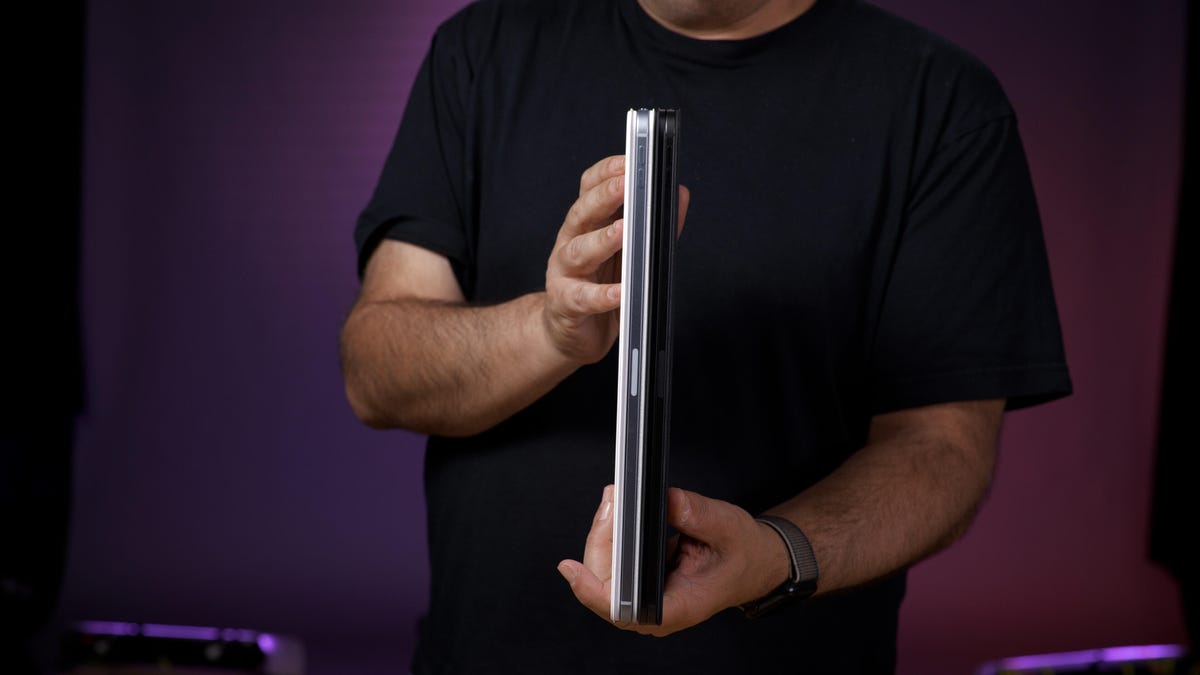
With Magic Keyboard cases attached, the 2024 iPad Pro and iPad Air don’t seem tremendously different in thickness (but the Pro is thinner).
M4: Another big chip boost
For years, the iPad Pro has had processors that outperform what I use them for. A new M4 chipset — just half a year after Apple unveiled the M3 for Macs — was released with these new iPad Pros, raising questions about… why? Couldn’t the M3 have been good enough? From what Apple has discussed, it sounds like the M4 chip is better at managing power in a small design, which also could suggest that the M4 is a more versatile processor, even if it seems to share a lot of similarities to the M3 based on Apple’s descriptions. (Could this be the Vision Pro 2 chip someday? Well, let’s not get ahead of ourselves.)
It’s hard for me to figure out how to push the M4 in meaningful ways, and that’s because a lot of apps optimized for it aren’t here yet. Also, iPadOS still limits me to running four apps simultaneously in Stage Manager mode, which seems absurd since the iPad Pro now has a better CPU than my M2 MacBook Air.
Geekbench 6 benchmarks show a notable boost over the M2 chip on the previous iPad Pro (and now in the iPad Air), and even the M3 chip on the MacBook Air with a multicore score of 14,672 (versus 12,063 for the M3 MacBook Air), about a 21% boost in performance. But the M2 is still really fast. On the newest iPad Air models, Geekbench 6 multicore is 9,894, roughly what my trusty personal M2 MacBook Air can do. The problem isn’t speed for iPads, that’s for sure.
But, this year, Apple offers a different performance boost for higher-tiered iPad Pros — just like Macs. The 1TB and 2TB models have 16GB of RAM and 10 CPU cores in the M4, versus 8GB of RAM and nine CPU cores in the 256GB and 512GB configurations. I tested the 1TB model, so I don’t know how the entry-level model performance feels in comparison.
Battery life, while rated as still being about the same as always for iPads (roughly 10 hours), is still being tested. Over the last few days, it seemed to hold on well enough for a day’s use, but my MacBook Air still feels like it lasts longer on a charge.
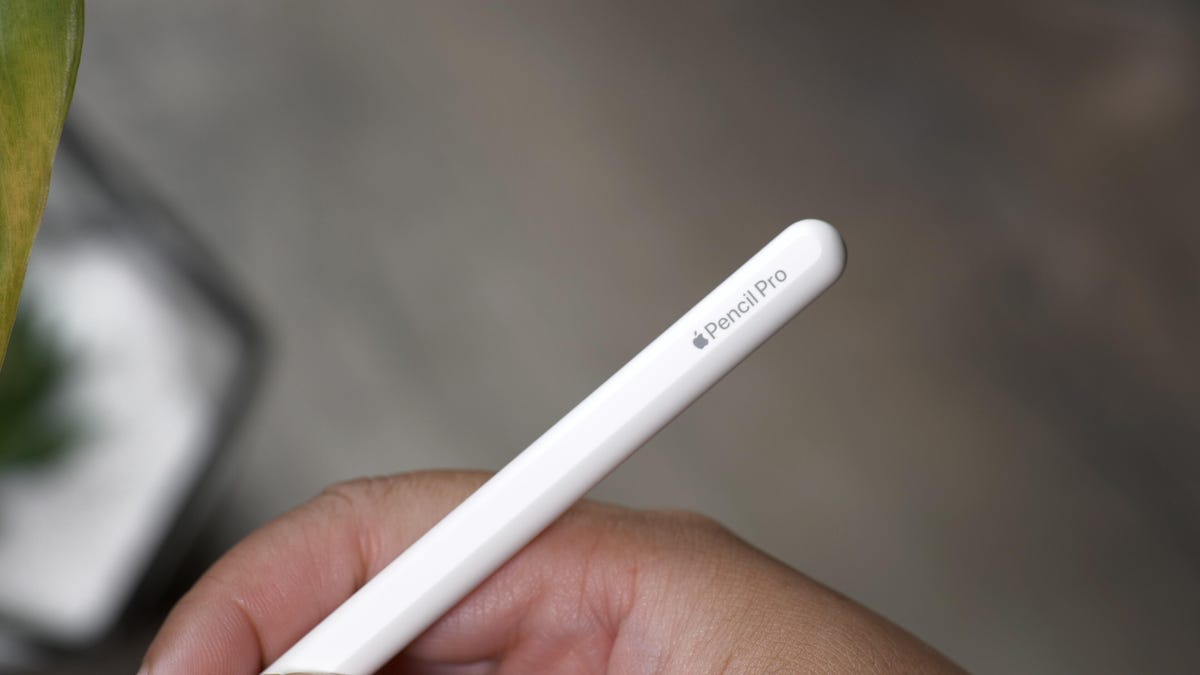
The Pencil Pro looks exactly the same as before but has new tricks inside.
Pencil Pro: The best Pencil, by degrees
It would be a no-brainer to recommend the new Pencil Pro if it were an accessory that worked with every existing Pencil 2-compatible iPad. It’s the same price ($129) and has exactly the same design. However, the Pencil Pro only works with the new iPad Pro and iPad Air 2024 models — and the Pencil 2 doesn’t connect to these new iPads, either. So, yeah: You’ll need to buy a new Pencil Pro if you’re upgrading, regardless.
That’s annoying, but at least the Pencil Pro’s extra features are helpful. An inner gyroscope means the Pencil has contextual rotation. It allows for brushes to be spun or turned, for example, giving an added dimension to control. The Pencil now has haptics and a squeeze gesture, too, which work together with the Pencil’s near-range “float” interactions with the iPads.
Squeeze in close range, and the Pencil Pro has an inner click which brings up an on-screen menu in apps that support the Pencil Pro (more on that in a bit). In practice, it means a quick shortcut to getting more instant tool-selection options than the double-tap feature on the Pencil 2, which just toggles with one other tool. (The Pencil Pro still has a double tap, too, though.)
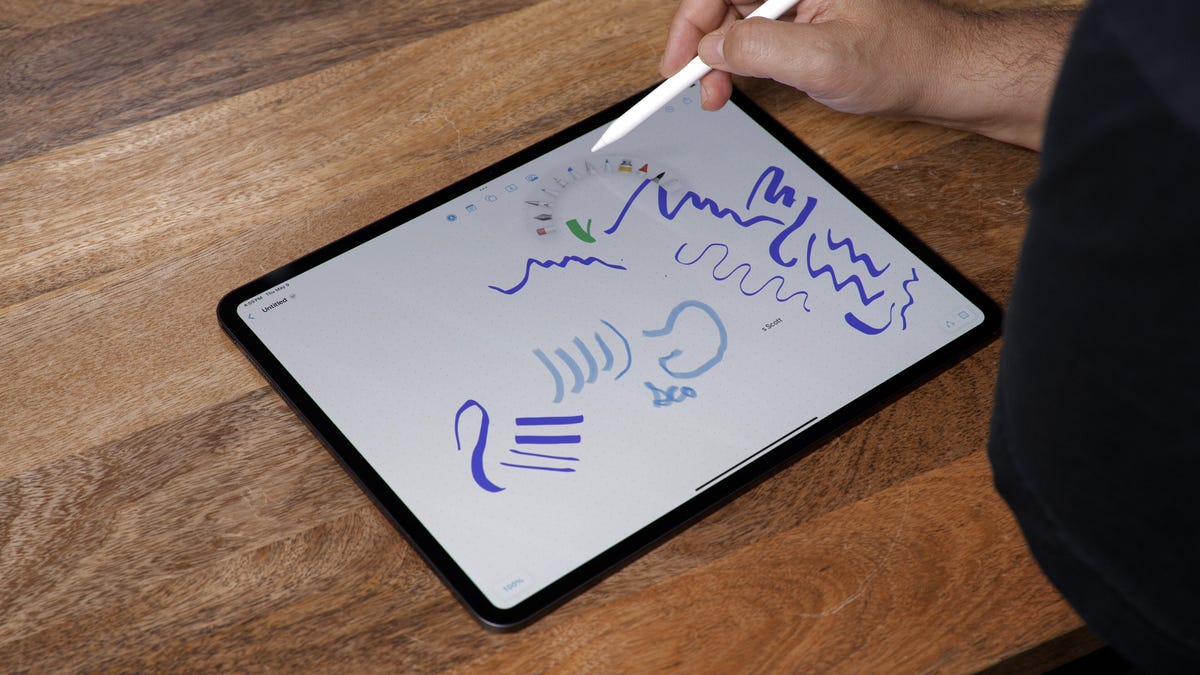
The Pencil Pro brings up a contextual menu onscreen when squeezed, when apps that have been upgraded add support for it.
I got a chance to try a few TestFlight beta previews of some apps using Pencil Pro: Procreate, Procreate Dreams, SketchUp, GoodNotes, Zinnia and Adobe Fresco. Apple’s Notes and Freeform have Pencil Pro extras, too. Knowing what pop-up squeeze menu icons do and mean can get confusing since they change in different apps. Other apps that don’t get updated to work with it won’t see any pop-up menus at all, meaning you miss out on one of the Pencil Pro key features. All in all, I’d rather have the squeeze and rotate bonuses. But I wouldn’t want to buy a whole new iPad to get them.
Are the Pencil Pro upgrades a preview of Apple Vision Pro accessories to come? I can’t help but wonder if the more 3D-capable, gyro-equipped Pencil Pro could somehow work with Vision Pro eventually, or if it’s a stepping-stone to an air stylus device. Either way, the iPad’s creative tools are the missing link to creative tools for Vision Pro. I’d appreciate it if the iPad worked with Vision Pro, but it doesn’t yet. Maybe this is part of Apple’s WWDC announcements in just a month.
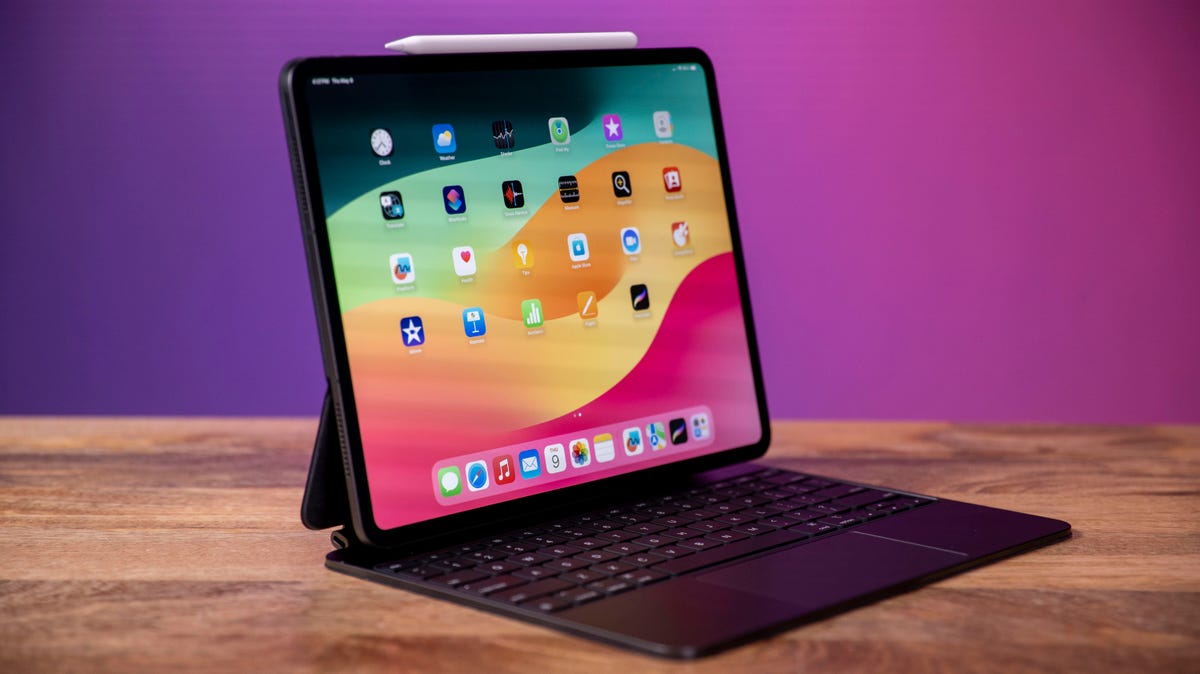
The iPad Pro’s new Magic Keyboard still opens up in the same way as the older version, although the new version is thinner and has a larger haptic trackpad (and function keys).
Magic Keyboard: Better, but the same idea
Much like the iPad Pro itself, the Magic Keyboard case improves while basically serving a similar proposition as it did before. At $350 for the 13-inch model version, it’s expensive. It’s also got a great keyboard that feels almost exactly like the MacBook’s. There’s a new row of function keys at last, and the larger trackpad has clickable haptics. But the case still feels top-heavy at times, tilting back a bit when I type on my lap at certain angles. And it’s not a good case for Pencil use.
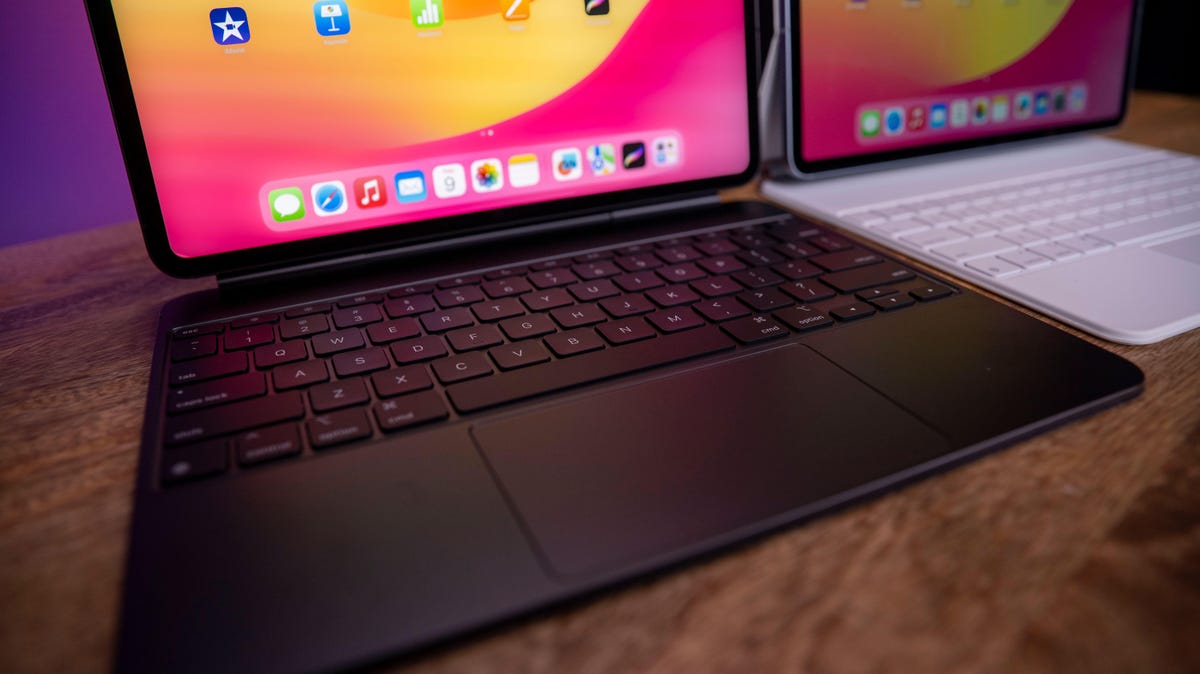
The larger haptic trackpad, row of function keys, and the aluminum inner palm rest are great. I wish the rest of the design was rethought, too.
The case magnetically attaches to the back of the iPad Pro just like other models did, “floating” the iPad and tilting it at a narrow range of angles. But it doesn’t let me pull the display down to a more comfortable drawing level. If I try writing on the display, it feels awkward. I want to pull the iPad off the magnetic back and put it on the table instead. The case still can’t flip back into a folio mode, either; it forces the iPad Pro into laptop form.
Microsoft faced these challenges with its Surface hardware, too, but Apple still hasn’t solved the perfect stylus/keyboard lifestyle combo here. I wish it had. It’s the case I’d get for the new iPad Pro, but it’s not a perfect keyboard case for this reason.
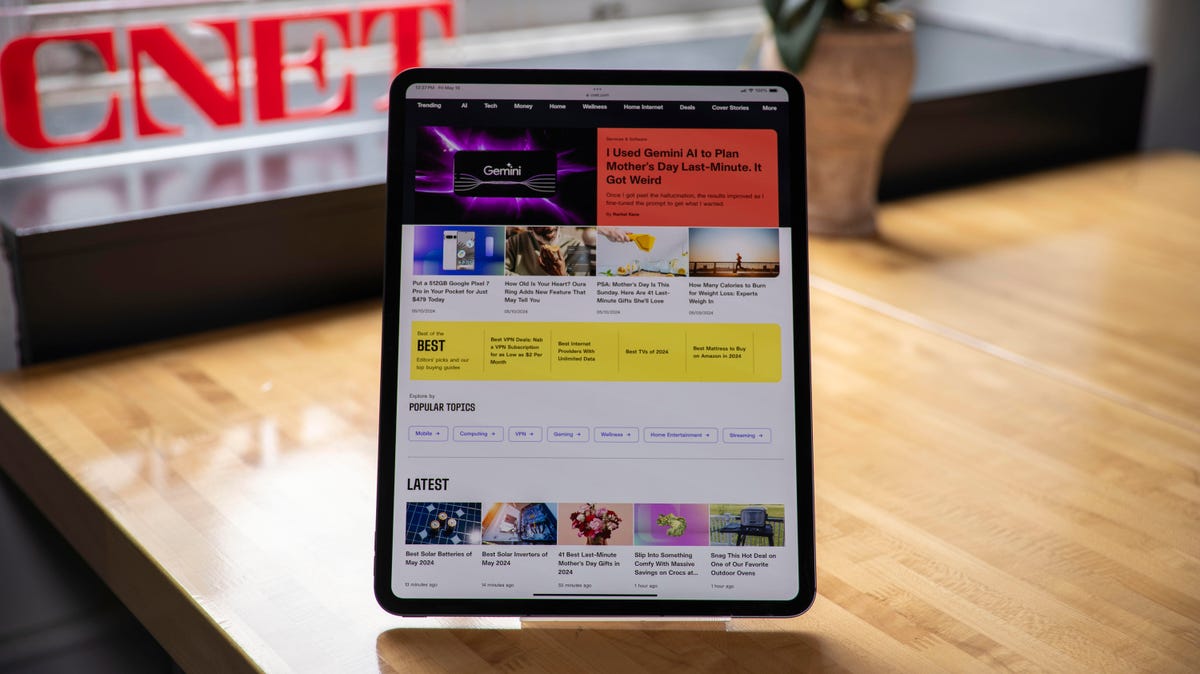
The iPad Pro is still a big blank slate of potential. There’s no reason Apple couldn’t reinvent it further.
What is the iPad becoming?
The future of the iPad Pro has been the present for so long that it’s hard to imagine how it will change. A keyboard, a trackpad, a Pencil, a processor that’s the same as Macs and, of course, a touchscreen: the iPad Pro has all the components to be a MacBook successor, or even a Mac with extended benefits. There’s no need for an iPadOS or MacOS divide at all when it comes to what runs on the iPad’s hardware; that’s all Apple’s arbitrary decision-making. Putting a touchscreen on a Mac and adapting MacOS to touch is one thing; adding a trackpad/keyboard-based MacOS to the iPad Pro’s already capable hardware is something much more doable. Why can’t it happen?
Apple has three computer varieties in its product lineup now: Macs, iPads and the Vision Pro. I haven’t forgotten about the Vision Pro, Apple’s three-month-old vision of head-worn future computing, because it stands a step ahead of the iPad now on that future-concept timeline. The iPad is a computer for tons of people now, my mom and kids included. It’s great. The iPad Pro, however, won’t be great for everyone until it’s more affordable — or it’s also a Mac.
And at some point, yes, I see wearable displays being a way to extend all these computers we use: phones, tablets and laptops alike. Apple needs to let its converging iPad Pro and MacBook lines finally and truly combine to make this pathway easier. Maybe WWDC will explain some of what iPadOS will evolve into to make more use of this hardware. Until then, the iPad Pro is the best fancy tablet Apple has ever made, but it’s far more than you probably ever need or would want to pay for. As to what this iPad Pro could be, well, Apple, hurry up: The future is now.





















+ There are no comments
Add yours